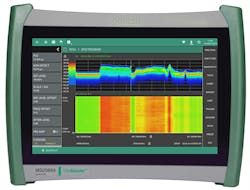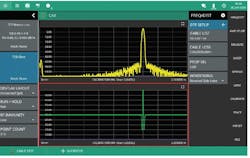Comprehensive Test Solutions Ensure Reliable EW Systems
- Issues with EW systems on modern military airframes.
- The importance of RF cable feeds.
- The importance of fast, accurate testing.
Electronic-Warfare Systems on Military Aircraft
How RF Cable Feeds Impact EW System Effectiveness and Reliability
Comprehensive Testing for Electronic-Warfare Systems: Ensuring Signal Integrity
While return loss can verify the health of an EW system, distance-to-fault (DTF) is the best technique to troubleshoot systems and locate problems. The most effective DTF measurement uses a fast Fourier transform (FFT) to convert frequency data to the time domain and display signal reflections with respect to distance. A standard trace math feature found in some analyzers can monitor small relative frequency changes over time.
To expedite analysis and locate issues in the EW system, some analyzers have a split screen display (see Fig. 2). It allows return loss and DTF to be on the same screen, so the position along the RF cable where the highest reflections are taking place can be pinpointed while also showing overall return loss. Identifying the issue through this feature speeds up the resolution of the fault.
The Importance of Fast, Accurate Tests
Given the mission-critical nature of EW systems, locating and rectifying an issue as fast as possible is paramount. When a return loss measurement identifies a cable and antenna path that does not meet specification, it is necessary to locate the cause of the reflection and repair it. A basic DTF measurement quickly locates the distance of the individual reflections from the input test port. For long cable runs, the more information known about the reflection cause, the quicker and easier the repair becomes.
That is why TDR measurements are important, as well. They show impedance against distance, with a normal 50-ohm line running across the center of the display. Different causes of reflections, such as open circuits, short circuits, kinks to the outer cable conductor and water ingress, will cause characteristic changes to the transmission line impedance. This aids in identifying the cause of the fault and accelerates the repair process.
A transmission measurement needs to be made on fixed transmission lines, including coaxial cables within aircraft wings and fuselage. A USB sensor can be integrated into an analyzer to conduct transmission measurements. Such a configuration allows technicians to make those measurements quickly and efficiently. Some instruments allow the measurement to be made simultaneously with reflection (Return Loss or VSWR) or DTF to facilitate system verification.
Compact Design, Comprehensive Testing
Much like the EW systems that they test, the instruments must be durable to produce the required consistently accurate results. Analyzers should be designed and tested to meet the MIL-PRF-28800F Section 4.5.6.3 Explosive Atmosphere requirements for safe usage on flight decks and in areas where high volatility may exist. Additionally, the solutions must be compact so they can be carried and used in the tight confines of the aircraft.
Conclusion
Testing aircraft EW systems and their components is a proactive approach to maintaining operational readiness. It involves comprehensive testing, dedicated solutions, and stringent maintenance schedules to mitigate risks and maximize mission success. Measuring signal performance of EW systems involves testing individual components, such as amplifier systems, signal generators, RF cables, and antennas, using solutions that integrate multiple instrument capability and can produce accurate and reliable results in harsh environments.


